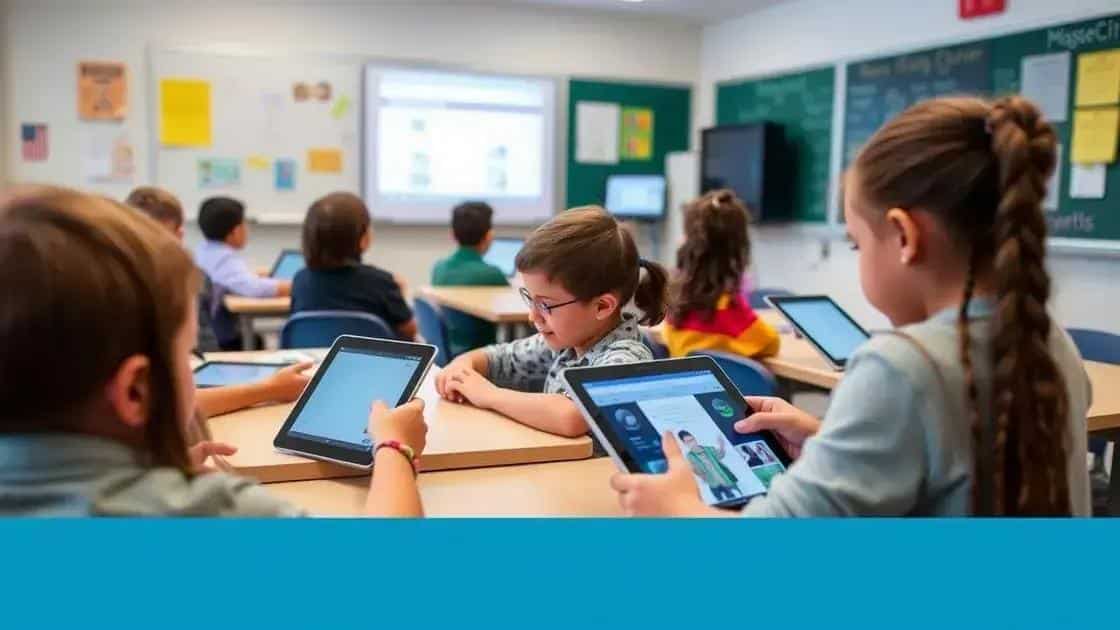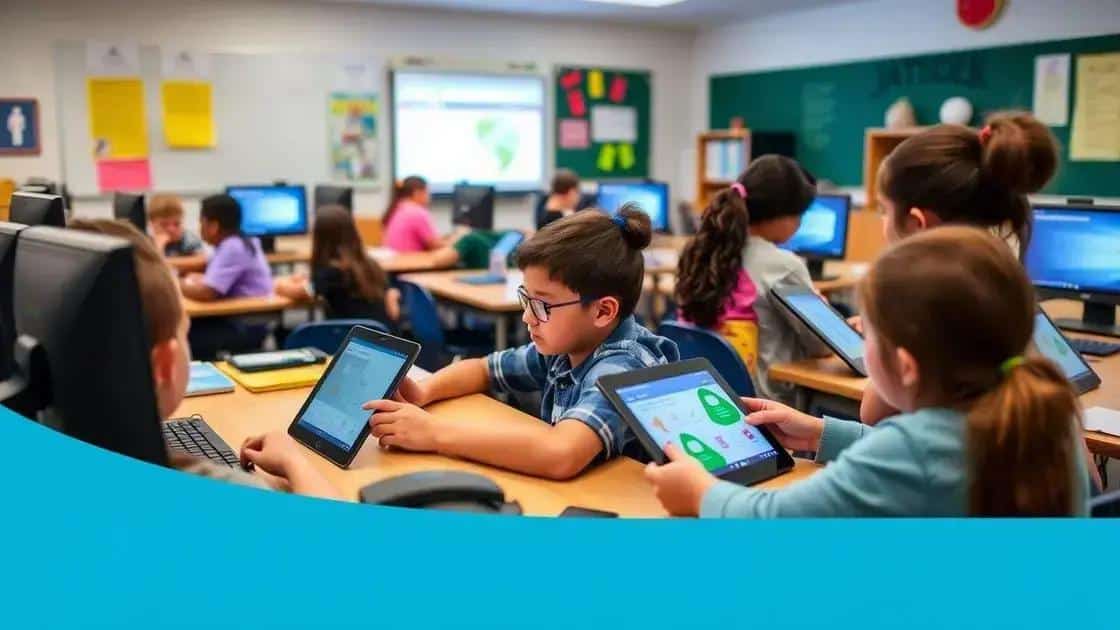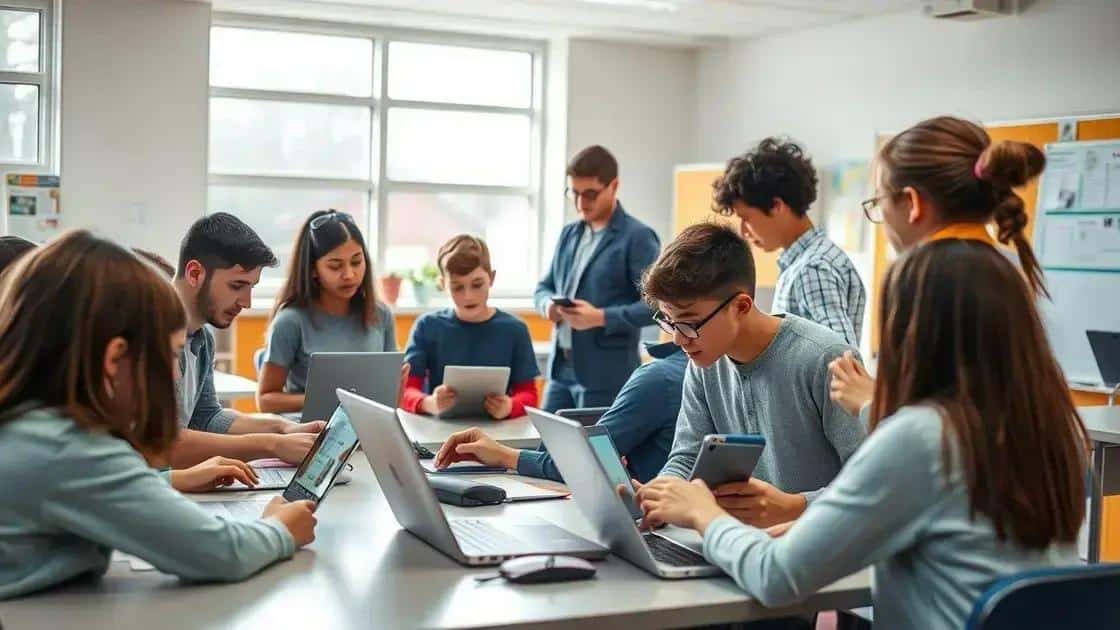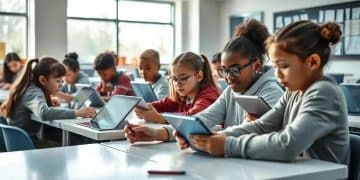Insights on school technology integration that boost learning

Insights on school technology integration reveal that effective practices include providing teacher training, addressing technical issues, ensuring digital equity, and utilizing engaging tools to enhance student learning experiences.
Insights on school technology integration are crucial in today’s digital age. Ever wondered how tech can transform your child’s learning experience? Let’s explore some impactful strategies.
Understanding the role of technology in education
Technology has become a vital part of modern education. Understanding the role of technology in education can significantly enhance learning experiences and outcomes for students.
Technology enhances engagement by providing interactive tools that make lessons more engaging. Students can explore complex topics through simulations and games, which help to reinforce learning.
Benefits of technology in education
Incorporating technology has multiple advantages:
- Personalized learning: Technology allows for customized lesson plans that cater to individual learning styles.
- Access to resources: Students can easily access a wealth of online resources and materials.
- Collaboration tools: Digital platforms enable students to collaborate effortlessly on projects.
- Real-time feedback: Teachers can provide immediate feedback on assignments through online systems.
Moreover, technology fosters collaboration. As students work together on projects using various digital tools, they develop essential skills like teamwork and communication. This collaboration often extends beyond the classroom, allowing for global connections that broaden perspectives.
Challenges in implementing technology
Despite its benefits, technology in education comes with challenges. Schools may face issues such as limited budgets for technology resources, lack of training for educators, and disparities in student access to devices. Addressing these challenges is crucial for maximized benefits.
Additionally, technology can sometimes distract students from their studies. It’s important for educators to establish guidelines and strategies that encourage focused use of digital tools. Incorporating technology involves balancing the advantages and challenges it presents to create an effective learning environment.
Ultimately, understanding the role of technology in education means embracing a future where learning is enriched by digital tools. By leveraging technology wisely, we can prepare students for success in an increasingly digital world.
Tools and platforms enhancing classroom learning

There are many tools and platforms available today that can enhance classroom learning. These technologies can make lessons more engaging, interactive, and accessible for students.
Using learning management systems is one effective way to streamline educational processes. These platforms organize course materials, track student progress, and facilitate communication between teachers and students.
Popular tools in education
Some tools that significantly enhance learning include:
- Google Classroom: Simplifies assignment distribution and feedback, making classroom management easier.
- Kahoot!: An interactive quiz platform that encourages participation through games.
- Edmodo: A social learning platform that connects students and educators.
- Nearpod: An immersive presentation tool that combines interactive lessons with real-time assessment.
Furthermore, incorporating educational apps into lessons can provide students with additional resources to reinforce their learning. Apps like Quizlet and Duolingo cater to different subjects and learning styles, helping students grasp concepts at their own pace.
Collaboration tools
Collaboration tools are essential for teamwork in the classroom. Using platforms like Microsoft Teams or Slack can facilitate group projects, allowing students to communicate effectively, share files, and collaborate in real-time.
Additionally, video conferencing tools such as Zoom or Google Meet enable virtual learning and can connect students with experts worldwide. This exposure helps broaden their understanding of various subjects and cultures.
By leveraging these tools and platforms, educators can create a dynamic learning environment that engages and inspires students. The integration of technology not only supports diverse learning needs but also prepares students for the digital world they will encounter in their futures.
Best practices for integrating technology effectively
Integrating technology into education can transform learning experiences when done effectively. Following best practices is essential for maximizing the benefits of technological tools in the classroom.
First, it’s crucial to provide adequate training for teachers. Educators should feel comfortable using new technologies and understand how these tools can enhance their teaching methods. Regular professional development sessions can equip them with the necessary skills.
Establishing clear objectives
Setting clear objectives is another vital step. Teachers should determine how they want technology to support learning goals. When technology use is aligned with educational outcomes, students can engage more meaningfully.
- Focus on engagement: Use technology to create interactive and engaging lessons.
- Differentiation: Implement various technologies to cater to different learning styles.
- Assessment: Utilize digital tools for assessing student progress in real-time.
Additionally, choosing the right tools is fundamental. Selecting platforms and applications that suit the specific needs of the classroom can significantly impact students’ learning experiences. Evaluate tools based on usability, accessibility, and the educational value they provide.
Encouraging collaboration
Encouraging collaboration among students enhances the learning environment. Technology fosters teamwork through group projects and collaborative platforms. Through these methods, students learn to communicate and work with each other.
Maintaining an open line of communication with parents can also be beneficial. Parents should be informed about how technology is being used in the classroom. This transparency builds trust and encourages support from home.
Ultimately, the integration of technology in education is an ongoing process. By continuously evaluating practices, teachers can adapt and refine their approaches, ensuring that technology remains an effective tool for enhancing student learning.
Challenges and solutions in technology integration

While integrating technology into education has many benefits, it also brings a number of challenges that educators must navigate. Understanding these challenges can help schools develop effective solutions.
One common issue is the lack of adequate training for teachers. Without proper knowledge and skills, educators can struggle to use technology effectively in their classrooms. Professional development opportunities are essential to equip teachers with the necessary skills to feel confident about technology integration.
Technical issues
Another challenge involves technical problems such as unreliable internet access or malfunctioning devices. These hurdles can disrupt lessons and cause frustration for both teachers and students. Having a dedicated IT support team can help ensure that technology runs smoothly in the classroom.
- Regular maintenance: Schedule routine checks on devices to prevent issues.
- Support resources: Provide support resources for troubleshooting common problems.
- Backup plans: Develop alternative lesson plans in case technology fails during a class.
Additionally, digital equity is a significant concern. Not all students have equal access to technology outside the classroom. Schools can address this by providing devices and internet access to those in need, ensuring that all students have equal learning opportunities.
Engagement and distraction
Maintaining student engagement is crucial, as technology can sometimes lead to distraction. It’s essential to establish clear guidelines for technology use during lessons. Teachers need to create a balance, ensuring that students use technology as a learning tool rather than a source of distraction.
Lastly, assessing student progress using technology can be challenging. Educators should explore various assessment tools to find ones that accurately measure learning outcomes. Using a mix of formative and summative assessments can provide a well-rounded view of student achievement.
By acknowledging these challenges and proactively creating solutions, schools can transform technology integration into a successful and enriching experience for students and educators alike.
FAQ – Frequently Asked Questions about Technology Integration in Education
What are the key benefits of integrating technology in the classroom?
Integrating technology enhances student engagement, supports personalized learning, and provides access to diverse resources.
What challenges do educators face when incorporating technology?
Challenges include lack of teacher training, technical issues, and ensuring digital equity among students.
How can schools ensure effective use of technology?
Schools can provide adequate training for teachers, establish clear objectives, and ask for technical support when needed.
What tools are recommended for classroom technology integration?
Popular tools include Google Classroom, Kahoot!, and Edmodo, which enhance collaboration and learning.





